新人教版高中英语必修一名师优秀教案
人教版高中英语必修1教案5篇
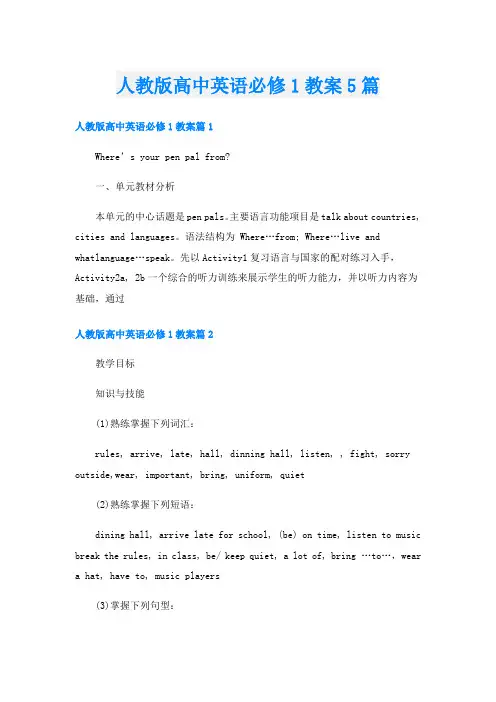
人教版高中英语必修1教案5篇人教版高中英语必修1教案篇1Where’s your pen pal from?一、单元教材分析本单元的中心话题是pen pals。
主要语言功能项目是talk about countries, cities and languages。
语法结构为 Where…from; Where…live and whatlanguage…speak。
先以Activity1复习语言与国家的配对练习入手,Activity2a, 2b一个综合的听力训练来展示学生的听力能力,并以听力内容为基础,通过人教版高中英语必修1教案篇2教学目标知识与技能(1)熟练掌握下列词汇:rules, arrive, late, hall, dinning hall, listen, , fight, sorry outside,wear, important, bring, uniform, quiet(2)熟练掌握下列短语:dining hall, arrive late for school, (be) on time, listen to music break the rules, in class, be/ keep quiet, a lot of, bring …to…,weara hat, have to, music players(3)掌握下列句型:1. Dont eat in class.2. You must be on time.3. Eat in the dining hall.4. 正确使用情态动词can, can’t——Can we wear a hat in school?——Yes, we can./No, we can’t.5. 能正确使用have to 和 must 谈论规章制度We must be on time/ We also have to be quiet in the library. 教学重难点重点:1) 肯定祈使句是省略掉主语的原形动词开头;2) 否定祈使句则是在肯定祈使句前加上“don’t”。
英语人教版高中必修一(新课标)教案Unit1 Reading for Writing 教案
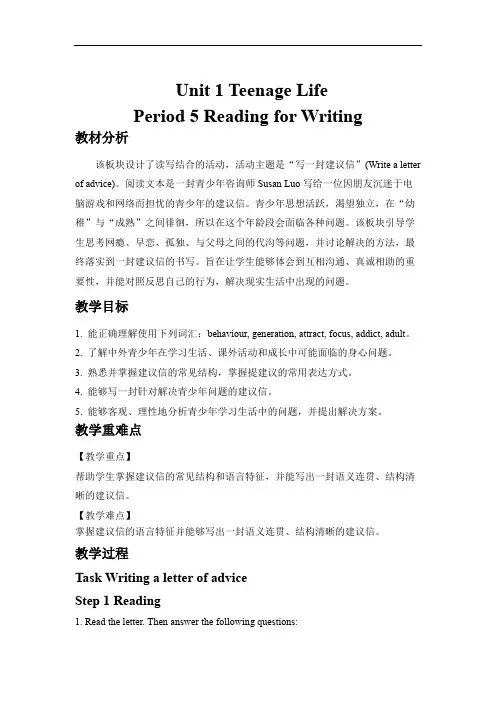
Unit 1 Teenage LifePeriod 5 Reading for Writing教材分析该板块设计了读写结合的活动,活动主题是“写一封建议信”(Write a letter of advice)。
阅读文本是一封青少年咨询师Susan Luo写给一位因朋友沉迷于电脑游戏和网络而担忧的青少年的建议信。
青少年思想活跃,渴望独立,在“幼稚”与“成熟”之间徘徊,所以在这个年龄段会面临各种问题。
该板块引导学生思考网瘾、早恋、孤独、与父母之间的代沟等问题,并讨论解决的方法,最终落实到一封建议信的书写。
旨在让学生能够体会到互相沟通、真诚相助的重要性,并能对照反思自己的行为,解决现实生活中出现的问题。
教学目标1. 能正确理解使用下列词汇:behaviour, generation, attract, focus, addict, adult。
2. 了解中外青少年在学习生活、课外活动和成长中可能面临的身心问题。
3. 熟悉并掌握建议信的常见结构,掌握提建议的常用表达方式。
4. 能够写一封针对解决青少年问题的建议信。
5. 能够客观、理性地分析青少年学习生活中的问题,并提出解决方案。
教学重难点【教学重点】帮助学生掌握建议信的常见结构和语言特征,并能写出一封语义连贯、结构清晰的建议信。
【教学难点】掌握建议信的语言特征并能够写出一封语义连贯、结构清晰的建议信。
教学过程Task Writing a letter of adviceStep 1 Reading1. Read the letter. Then answer the following questions:(1) What is Worried Friend’s problem?(2) What suggestions does Susan Luo give to Worried Friend?(3) Besides suggestions, what else does Susan Luo say in her letter?Step 2 Pre-writing2. Work on Activity 1. Students discuss the last 2 questions in groups.3. Work on Activity 2. Study the organisation and language features. Then summarize the expressions used to make suggestions.设计意图:该环节属于语言输入阶段,活动一关注阅读文本内容,活动二关注文本结构和语言特点。
2020年新人教版高中英语必修一教案全套
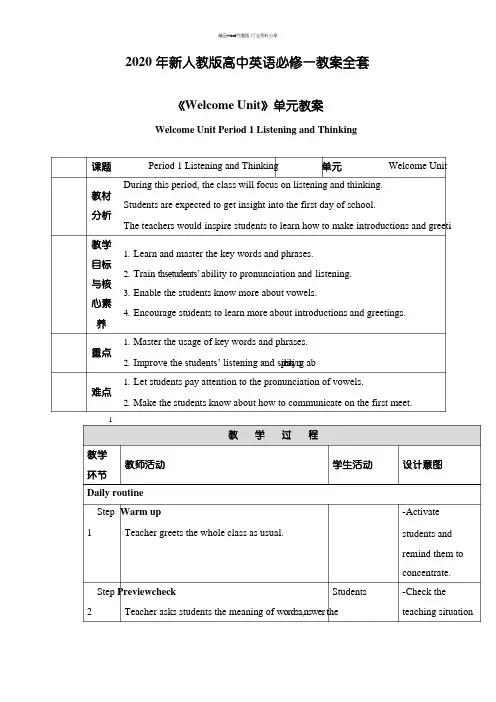
2020 年新人教版高中英语必修一教案全套《Welcome Unit》单元教案Welcome Unit Period 1 Listening and Thinking课题Period 1 Listening and Thinking 单元Welcome Unit During this period, the class will focus on listening and thinking.教材Students are expected to get insight into the first day of school.分析The teachers would inspire students to learn how to make introductions and greeti教学1.Learn and master the key words and phrases.目标2.Train thsetudents’ ability to pronunciation and listening.与核3.Enable the students know more about vowels.心素4.Encourage students to learn more about introductions and greetings.养1.Master the usage of key words and phrases.重点2.Improve the students’ listening and s p i e l a i k t i y n.g ab1.Let students pay attention to the pronunciation of vowels.难点2.Make the students know about how to communicate on the first meet.1教学过程教学教师活动学生活动设计意图环节Daily routineStep Warm up - A ctivate1 Teacher greets the whole class as usual. students andremind them toconcentrate. Step Preview c heck Students - C heck the2 Teacher asks students the meaning of wordsa,nswer the teaching situationphrases and knowledge points learnt last l q e u s e s s o t n i.o n sloudlytogether. Lead-in of last lesson quickly.- Help students consolidate the knowledge points.Step 3SayingTeacher shows the pictures to lead the topic.A thousand-mile journey begins with the first step.—Laozi- U se picturesto catch students’attention.- E xpand theirhorizons andspark theirinterest.1.Do you think so?2.What’s your first step?Afteracknowledging3.Do you think the first step is very theimportant?Video: Lost On The First Day Of HighSchoolinformation andthe meaning ofthe new words,answer theStep 4What did the girl experience on the f irs q t uestions. day?What was her feeling?How do you feel on the first day of s chool? Why so?New wordsTeacher explains the meaning of the newwords, and asks students to translate the meaning - Teach themeaning of newwords.of the whole sentence.Step 5exchangeexchange programmeexchange studentslecturesexfemale-malenationnationalitycampusThey wanted to design a machine that was bothattractive and practical.designerHe wrote a very formal letter of apology to Douglas.informal Let’splayTeacher choses students to answer thequestions.1.She lives on (= within themain university area).2.One evening the company arranged adinner after the play.3.We may be able to a course tosuit your particular needs.4.Have you come to at theschool?5.It was a story that touched the- F amiliarizethe new words- Clear the tackle oflistening practice.heart.6.He used to me about getting too much sun.keys:1.campus2. formal3. design4. register5. nation’s6. lectureStep 6Pair workDiscuss the questions in groups.Match the pictures with the s entences.Discuss withtheir patternerand voice their- FamiliarizeStudents with keywords.- M akeA My name is Amy. I'd like to have a s t u o d p e i n n t i o n s I D card,please.B Hi, I'm Max Jackson. I'm an exchangestudent from the UK.C Hello, everyone! Welcome to our school!Describe what the people in the pictures a re doing.Listening & Speaking students use core words and phrases. - Exercise students’ expression and speaking skills.Step Listening practice Listen to the - F amiliarize7 Teacher shows the questions. Then teachemraterials plays thelistening material and asks s t u d c e a n r t e s f u t l o l y and students with key words.answer. do the - E xerciseAmy is getting her student ID card. List l e i n stening to Conversation 1 and complete the table. e xercises. Keys: students’ speaking skills.1. 1701432.Amy Jones3.the USA4.1/One5.amyj16@Max meets Amy in the dining hall. Listen t o Conversation 2 and tick Max's favorite subject and Amy's favorite subject.Keys:1.maths2.chemistryAmy is talking to Ms Li, a school a dviser, about which courses to choose.Listen to Conversation 3 and answer the questions.1.What does Amy want to be in thefuture?A An engineer B. A designer. C A writer.2.What course will Amy probably choose?A EnglishB. IT.Keys:1. BC Art.2. CStep 8People speak insituations.IntroductionsMy name is ...a more polite way in forma S l tudentslisten totips.the- Help students learntips in listeningpractice.- M akeI'm ...This is ...Have you met ...? Doyou know ...?May I introduce ...?I'd like you to meet ...I don't believe you know ...GreetingsHi/Hello! Goodmorning!What's up?How's it going?How are things going? How are you?How are you doing? Nice/Glad to meet you.ResponsesHi/Hey!Morning!Not much.Great!I'm fine, and you? Very well, thank you. How about you?Nice/Glad to meet you, too.Break the ice“Break the ice” is a common English expression. It means “to get comfortable with someone.”students masterthe listening skill better. - Better finish the testing task.After the first greeting, the best way to break the ice is to ask for very basic information. This gives you a reason for starting the conversation.Here are some examples:How are you?Where are you from?What are you doing here? or What brings you here?Are you having a good time?Prepare some basic answers about yourself now, sothat you can introduce yourself with confidence and perfect English in the moment.Keep your answers short and simple so youless timehave less time to make mis—ta a k n e d s tolose so e m one’s attention!E.g.Where are you from?What do you do?What are you doing here?How was your trip?Are you having a good time?What do you think of the weather?Even when questions are specific, you can have a general response prepared. Say something generally positive, then add in more detail.Adding the detail keeps the conversationStep interesting. Then you can ask a question.Discussion Use what - V oice their9Teacher shows the topic and gives studentthsey have opinions.examples to discuss. learnt from the - P ractice theirWork in groups. Choose one of the interview tohelp you andteam spirit.- P ractice theirsituations and make a conversation. Try t o d i u s s c e u s s in thinking skill andthe introductions and greetings b elow.A boy meets a girl during a break. groups. imagination.- P ractice their speaking andAn exchange student is talking to a teacher on campus.A boy and a girl are at the airport to meet a visiting groupof teachers and students from England.listening.StepRole play your conversations or thingshappened on the first day of school!Pronunciation Students do - I mprove the10the exercises.students’Listen and repeat. Notice the pronunciation of the vowels (A, E, I, O, U). Then add a w ord to each group. pronunciation skill./ei/ /x/ grade escape m ap /i:/ /e/ these Chinesecampus met forget/ai/ /I/ w rite /au/ ID/ h ope alive quizalone froglisten coffee/ju:/ ht/use future up discussStep 11 Video: VOWEL SOUNDS Learn therelatedknowledgepoint.- Help studentsunderstand andmaster relatedknowledge points.Step Language points Listen to the - Help s tudents 12 Teacher explains the language points andkey knowledge know about themakes some exercise.1.exchange n.交换;交流vt.交换;交流;交易;兑换I’m an exchange student from the Uk.points carefullyand take exercise.knowledge pointsdeeper.- Let studentsknow how to usethese words andphrases.exchange studen互t派留学生exchange programmes交流项目exchange teacher互s 派教师exchange message交换信息an exchange of glanc交es换眼神an exchange of informati交on换信息in exchange f o用r …交换exchange blows互殴,打起来God offers to exchange what He has for what we have.上帝愿意用他所拥有的来交换我们所拥有的。
人教英语必修一_Unit5_Discovering_Useful_Structures_名师教学设计
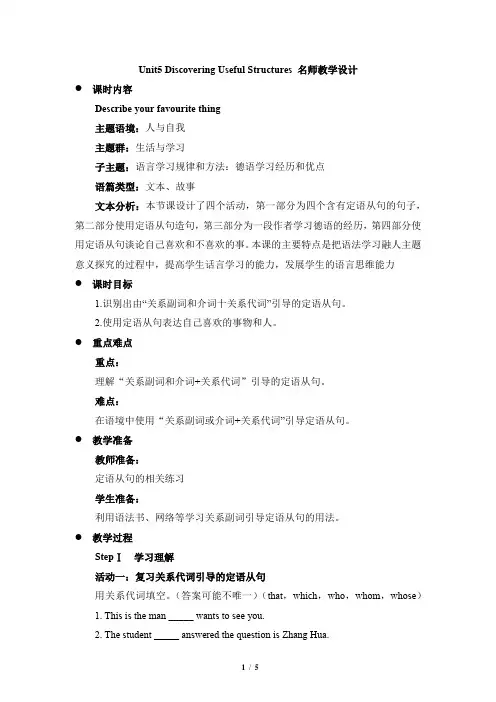
Unit5 Discovering Useful Structures 名师教学设计●课时内容Describe your favourite thing主题语境:人与自我主题群:生活与学习子主题:语言学习规律和方法:德语学习经历和优点语篇类型:文本、故事文本分析:本节课设计了四个活动,第一部分为四个含有定语从句的句子,第二部分使用定语从句造句,第三部分为一段作者学习德语的经历,第四部分使用定语从句谈论自己喜欢和不喜欢的事。
本课的主要特点是把语法学习融人主题意义探究的过程中,提高学生话言学习的能力,发展学生的语言思维能力●课时目标1.识别出由“关系副词和介词十关系代词”引导的定语从句。
2.使用定语从句表达自己喜欢的事物和人。
●重点难点重点:理解“关系副词和介词+关系代词”引导的定语从句。
难点:在语境中使用“关系副词或介词+关系代词”引导定语从句。
●教学准备教师准备:定语从句的相关练习学生准备:利用语法书、网络等学习关系副词引导定语从句的用法。
●教学过程StepⅠ学习理解活动一:复习关系代词引导的定语从句用关系代词填空。
(答案可能不唯一)(that,which,who,whom,whose)1. This is the man _____ wants to see you.2. The student _____ answered the question is Zhang Hua.3. The man _____ you went to see has come.4. The runner _____ you are asking about is over there.5. The person _____ you should write to is Mr. Ball.6. The man _____ was passing by saw what happened.7. Here is the pen _____ you lost the day before yesterday.8. These books _____ you lent me were very useful.9. The storybook _____ I have just read cannot be easily forgotten.10. A clock is a machine _____ tells people the time.Suggested answers:1. who/that2. who/that3. whom/that4. whom/that5. whom/that6. who/that7. which/that8. which/that9. which/that 10. which/that 活动二:识别时态(SB,P64,Part1)1. Understand the sentences. Ask students to read the four sentences and translate it into Chinese to understand their meaning.2. Recognize the tense. Ask students to work in groups first to underline the restrictive relative clauses and discuss the tense and try to analyze how it is used.【设计意图】通过翻译句子,讨论时态,教师适当讲解,学生在学习过关系代词引导的定语从句之后,进一步理解关系副词引导的定语从句。
人教课标版高一英语必修一一等奖说课稿
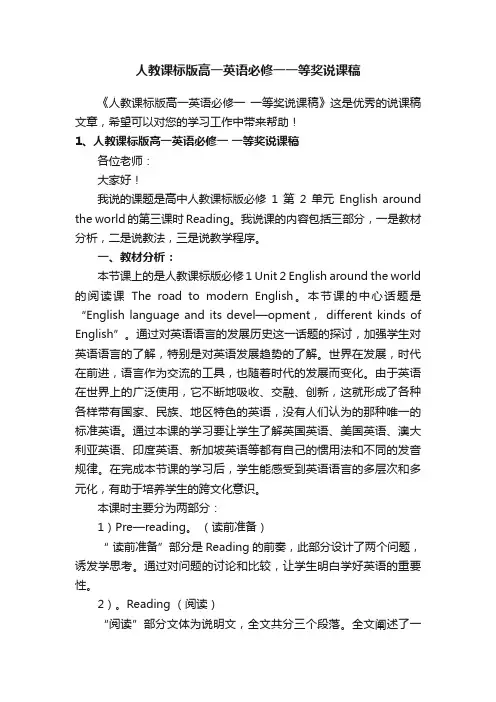
人教课标版高一英语必修一一等奖说课稿《人教课标版高一英语必修一一等奖说课稿》这是优秀的说课稿文章,希望可以对您的学习工作中带来帮助!1、人教课标版高一英语必修一一等奖说课稿各位老师:大家好!我说的课题是高中人教课标版必修1第2单元English around the world的第三课时Reading。
我说课的内容包括三部分,一是教材分析,二是说教法,三是说教学程序。
一、教材分析:本节课上的是人教课标版必修1 Unit 2 English around the world 的阅读课The road to modern English。
本节课的中心话题是“English language and its devel—opment,different kinds of English”。
通过对英语语言的发展历史这一话题的探讨,加强学生对英语语言的了解,特别是对英语发展趋势的了解。
世界在发展,时代在前进,语言作为交流的工具,也随着时代的发展而变化。
由于英语在世界上的广泛使用,它不断地吸收、交融、创新,这就形成了各种各样带有国家、民族、地区特色的英语,没有人们认为的那种唯一的标准英语。
通过本课的学习要让学生了解英国英语、美国英语、澳大利亚英语、印度英语、新加坡英语等都有自己的惯用法和不同的发音规律。
在完成本节课的学习后,学生能感受到英语语言的多层次和多元化,有助于培养学生的跨文化意识。
本课时主要分为两部分:1)Pre—reading。
(读前准备)“ 读前准备”部分是Reading的前奏,此部分设计了两个问题,诱发学思考。
通过对问题的讨论和比较,让学生明白学好英语的重要性。
2)。
Reading (阅读)“阅读”部分文体为说明文,全文共分三个段落。
全文阐述了一个鲜明的观点:英语的确是当今世界范围内使用最广泛的一门语言之一,也是联合国的工作语言之一,它的重要作用是其他语言不可替代的。
3)Post—reading(读后)“读后”部分共设计了两类题型:第一部分是和个问题,其中前面两个是细节理解题;第三题是一个开放性题目,鼓励学生把英语学习与现实生活相结合。
英语人教版高中必修一(新课标)教案Unit2 Listening and Speaking 教案
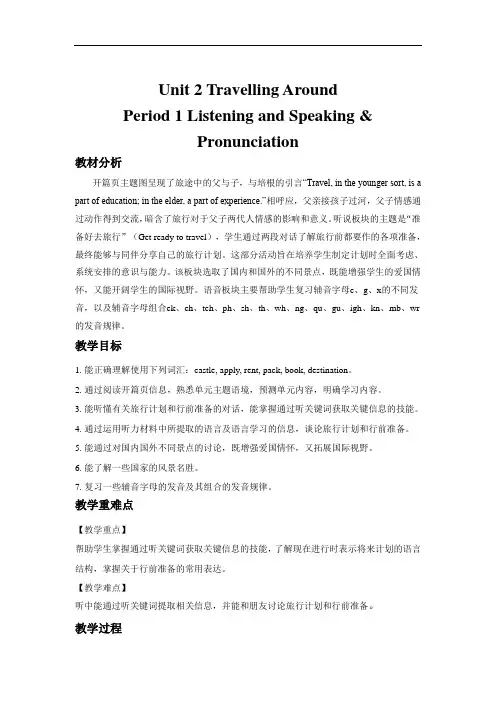
Unit 2 Travelling AroundPeriod 1 Listening and Speaking &Pronunciation教材分析开篇页主题图呈现了旅途中的父与子,与培根的引言“Travel, in the younger sort, is a part of education; in the elder, a part of experience.”相呼应,父亲接孩子过河,父子情感通过动作得到交流,暗含了旅行对于父子两代人情感的影响和意义。
听说板块的主题是“准备好去旅行”(Get ready to travel),学生通过两段对话了解旅行前都要作的各项准备,最终能够与同伴分享自己的旅行计划。
这部分活动旨在培养学生制定计划时全面考虑、系统安排的意识与能力。
该板块选取了国内和国外的不同景点,既能增强学生的爱国情怀,又能开阔学生的国际视野。
语音板块主要帮助学生复习辅音字母c、g、x的不同发音,以及辅音字母组合ck、ch、tch、ph、sh、th、wh、ng、qu、gu、igh、kn、mb、wr 的发音规律。
教学目标1.能正确理解使用下列词汇:castle, apply, rent, pack, book, destination。
2.通过阅读开篇页信息,熟悉单元主题语境,预测单元内容,明确学习内容。
3.能听懂有关旅行计划和行前准备的对话,能掌握通过听关键词获取关键信息的技能。
4.通过运用听力材料中所提取的语言及语言学习的信息,谈论旅行计划和行前准备。
5.能通过对国内国外不同景点的讨论,既增强爱国情怀,又拓展国际视野。
6.能了解一些国家的风景名胜。
7.复习一些辅音字母的发音及其组合的发音规律。
教学重难点【教学重点】帮助学生掌握通过听关键词获取关键信息的技能,了解现在进行时表示将来计划的语言结构,掌握关于行前准备的常用表达。
【教学难点】听中能通过听关键词提取相关信息,并能和朋友讨论旅行计划和行前准备。
高一英语必修一unit1教案(优秀3篇)
高一英语必修一unit1教案(优秀3篇)高一英语必修一unit1教案篇一一、指导思想:新的学年,我将按照“规范教学管理,创新教学方式,突出教研重点,注重教研实效”工作思路展开各项教学工作。
针对我们班新生普遍英语底子差,基础薄薄弱的实际情况,老师们要坚持用“夯实基础,狠抓双基,使用导学案教法,改进学法,激发兴趣,提高能力”的指导思想来指导自己的工作。
主要教学内容:高一必修1、必修2(1-2模块)的内容。
二、具体安排:高一必修1及必修2(1-2模块)共8个模块,计划安排每一模块用10课时,新授8课时,练习2课时,共用4个月的时间。
三.具体措施:1.注意教学的承上启下为了使学生打牢基础不至于出现知识断层,本学期开学要重新学习音标,另外要有计划的把学生初中学过的但掌握不好的时态、句式、定语从句、状语从句、动词不定式以及部分掌握不好的词汇、短语、句型分插于12单元的新课教学中。
2、认真研究新课程标准要认真研读新课程标准,尤其与旧大纲不同的地方,认真研究新教材,采取用导学案的方法给学生上课,着重培养学生们独立自主的学习能力,培养小组合作精神,在集体备课的基础上认真备课、上课,认真进行自习辅导和批改作业。
4、听评课坚持教学研究和相互听课,探究如何听评课。
我要和其他教师互相学习,取长补短。
5、教案的书写本学期高一备课组要继续探讨如何规范书写教案。
备课组活动中将把教案细分,逐一探讨。
如:如何正确书写教学目标。
教学方法有哪些等等。
四.夯实基础1.听力从高一就开始就对学生进行听力训练。
每周坚持上听力课,另外每周至少两次利用课余时间给学生集体放听力,并鼓励学生课余时间多泛听。
2、单词单词一直是学生的难点、薄弱点,直接影响学生综合能力的提高,在教学中要重视词汇教学,狠抓单词的记忆与巩固以及对词汇的意义与用法的掌握。
使学生掌握科学的单词记忆方法和养成勤查词典的习惯。
3、阅读阅读理解能力的培养是高一教学的重点,也是高考的重头戏。
最新人教版高中英语必修一+Unit+1++Friendship全单元教案(精品)名师优秀教案
人教版高中英语必修一 Unit 1 Friendship全单元教案(精品)Unit 1 Friendship知识目标:本单元需要学习的重点单词为:add point upset ignore calm concern loose cheat reason list share feelingNetherlands German outdoors crazy nature purpose dare thunder entirely poweraccording trust indoors suffer teenager advice questionnaire quiz situation editorcommunicate habit本单元需要学习的重点词组为:add up calm down have got to be concerned about walk the dog go through hideaway set down a series of on purpose in order to in one’s power face to faceaccording to get along with fall in love join in make an effort show one’s interest inspread far and wide pay (no)attention to in the past本单元需要学习的重点句型为:1. You want to see a very interesting film with your friend, but your friend can’t go until he or she finishes cleaning the bicycle. (not. . . until. . . )2. When he or she borrowed it last time, he or she broke it and you had to pay to get itrepaired. (get sth. done)3. While walking the dog, you were careless and it got loose and was hit by a car. (while doing; get+adj. )4. Your friend, who doesn’t work hard, asks you to help him or her to cheat in the exam by looking at your paper, what will you do? (the Attributive Clause)5. I don’t want to set down a series of facts in a diary as most people do, but I want this diary itself to be my friend. (as. . . )6. I wonder if it’s because I haven’t been able to be outdoors for so long time that I’ve grownso crazy about everything to do with nature. (I wonder if/whether; it’s . . . that. . . )7. . . . I stayed awake on purpose until half past eleven one evening in order to have a goodlook at the moon for once by myself. (stay+adj. ; in order todo. . . )8. But as the moon gave far too much light, I didn’t dare open a window. (don’t dare(to)do. . . )9. . . . it was the first time in a year and a half that I’d seen the night face to face. . . (It is/was the first/second. . . time that+现在/过去完成时)10. Although I really try to talk to my classmates, I still find it hard to make good friendswith them. (find it+adj. /n. +to do. . . )本单元需要掌握的交际功能用语为:1. 态度(attitudes)Are you afraid that. . . ? I’ve grown so crazy about. . . I didn’t dare. . .2. 同意和不同意(agreement and disagreement)I agree. I think so. Exactly.I don’t agree. I don’t think so. I’m afraid not.3. 肯定程度(certainty)That’s correct. Of course not.本单元需要掌握的语法为:直接引语和间接引语(?):陈述句和疑问句1. 陈述句“I don’t want to set down a series of facts in a diary, ” said Anne.? Anne said that she didn’t want to set down a series of facts in a diary.2. 一般疑问句He asked, “Are you leaving tonight? ”? He asked us whether we were leaving that night.3. 特殊疑问句“When did you go to bed last night? ” father said to Anne.? Father asked Anne when she went to bed the night before.能力目标:1. 能运用所学语言讲述朋友间发生的事情以及朋友间的友谊和友情。
英语人教版高中必修一(新课标)教案Unit1 Listening and Talking 教案
Unit 1 Teenage LifePeriod 4 Listening and Talking教材分析该板块的活动主题为“为青少年策划一项营地活动”(Plan a camp for teenagers)。
听力文本是一段对话,Max与Cao Jing谈论周末各自参加探险营和国际青年营的计划。
两人分别介绍了营地的活动内容,表达了对营地生活的期待。
该板块从高中生颇感兴趣的营地活动出发,旨在激发学生的想象力,策划一个同龄人喜欢的营地活动,并使用“be going to+动词原形”及“will+动词原形”等表示将来打算或意愿的语言功能项目进行交流和讨论,进而提升学生的团队精神和沟通表达能力。
教学目标1. 能正确理解使用下列词汇:adventure, youth, expert。
2. 能够口头叙述计划和将要发生的事情。
3. 能正确使用“be going to+动词原形”及“will+动词原形”等结构表示将来打算或意愿。
教学重难点【教学重点】帮助学生理解并正确运用be going to do、will do、plan to do、there will be、hope to do等结构来表达将来要做的事情和计划。
【教学难点】理解并正确运用be going to do、there will be、hope to do等结构表示将来打算或意愿。
教学过程Task Plan a camp for teenagersStep 1 Pre-listening1.Look at the two pictures in Activity 1. Answer the following questions:(1)What kind of camp is Adventure Camp/International Youth Camp?(2)What activities will it include?(3)What can students learn in these activities?2.Read the sentences in Activity 1. Then predict the main idea of the conversation. Step 2 While-listening1. Work on Activity 1. Listen to the conversation and tick what are heard about the camps.2.Work on Activity 2. Underline the expressions in the sentences above that Cao Jing and Max use to talk about the future.设计意图:该环节让学生通过勾画听力文本中的目标结构,关注对话中如何表达将来要做的事情和计划。
新人教版高中英语必修一名师优秀教案
Unit 1 FriendshipPeriod 5Friendship in Hawaii(Reading task in the Workbook)整体设计从容说课This is the fifth teaching period of this unit. We should first get the students to review what they learned during last period. To test whether the students have understood and grasped the roles of Direct Speech and Indirect Speech, the teacher can offer them some revision exercises.This period mainly deals with Reading task on Page 44 in the Workbook. Friendship is valued in all cultures; it is often expressed in different ways. The reading passage introduces the way Hawaiians express friendship. Before they read the passage, ask students if they can think of any place in the world where Chinese and Western cultures live side by side. Places they might mention include Hong Kong, Macao, Singapore, the Philippines, and San Francisco. Ask them to describe what they imagine life to be like in such a place. Then have students read the passage. After they read it, have students talk with a partner and consider how the Hawaiian idea of friendship could help different peoples to get along with one another. Besides friendship, you may want to have students think of another way to communicate better with people from other cultures.教学重点1. Get the students to learn about the way Hawaiians express friendship.2. Get the students to learn to use the pattern:It is+p. p. +that. . .教学难点Get the students to be able to realize the cultural differences in the values of friendship.教学方法1. Task-based teaching and learning2. Cooperative learning3. Discussion教具准备The multimedia and other normal teaching tools三维目标Knowledge aims:1. Get the students to learn about the way Hawaiians express friendship.2. Get the students learn to use the pattern:It is+p. p. +that. . .Ability aims:Get the students to be able to realize the cultural differences in the values of friendship in addition to its importance in all cultures.Emotional aims:1. Get the students to share different opinions on friendship in different cultures.2. Develop their ability to deal with and cooperate with others.教学过程设计方案(一)→Step 1 Revision1. Check the homework exercises.2. Let the students do some grammar exercises.Show the students the exercises on the screen.1)Change the following direct speech into indirect speech and indirect speech into direct speech.(1)Mary said, “I came here last week. ”(2)Tom said to his mother, “I will help these children with their math next week. ”(3)Mother asked me whether I had finished my homework before I watched TV.(4)The man asked Julie what she had done recently.(5)Our teacher said to us, “The sun travels around the earth. ”2)Choose the right answer.(1)She asked______________ for the house.A. did I pay how muchB. I paid how muchC. how much did I payD. how much I paid(2)Jone said that light______________ much faster than sound.A. travelB. travelsC. is travelingD. traveled(3)The teacher asked me______________ I was interested in music.A. thatB. whatC. whetherD. whichSuggested answers:1)(1)Mary said (that)she had gone there the week before.(2)Tom told his mother (that)he would help those children with their math the next month.(3)Mother asked me, “Had you finished your homework before you watched TV? ”(4)The man asked Julie, “What have you done recently? ”(5)Our teacher told us (that)the sun travels around the earth.2)(1)D(2)B(3)C→Step 2 Lead-in1. Talk about different ways of showing friendship of minority groups in China.2. Compare Chinese ways of showing friendship with western ways. And discuss why there is a big difference. Therefore, show the sentence:Every culture has its own ways to show friendship.3. Ask students if they can think of any place in the world where Chinese and Western cultures live side by side. They may think of Hongkong, Macao, Singapore. And the teacher will add one more—Hawaii by showing the students a picture of views in Hawaii.→Step 3 Fast readingTell the students:It is said that Hawaii is a place where the east truly meets the west. Consider how people show their friendship in Hawaii.1. Show the students a picture which describes a girl is giving leis to others. Get them to find the information from the textbook.(Giving leis to one another is a way Hawaiians show their personal friendship. )2. Ask the students to read fast and find out more ways to show friendship in Hawaii to fill in the form.Word Meaningaloha3. According to the form, ask them to consider what friendship is in Hawaiians.→Step 4 Careful readingGet the students to read the 2nd paragraph carefully and answer the question:Why do many different peoples call Hawaii their home?(Hawaii is a place where people make one big community from many smaller communities. It means Hawaii has a rich cultural diversity. )→Step 5 DiscussionGet the students into groups to discuss questions.1. Why do many different peoples call Hawaii their home?2. How can people in Hawaii live in peace?3. Can you find similar things in your hometown? How do you show friendship to visitors?→Step 6 Language PointsUseful sentence pattern:It is believed that the islands can be a paradise when people live in peace.The pattern is “It is+p. p. +that. . . ”. It’s very useful and common. For example, It is said that. . . /It is reported that. . . /It is considered that. . . /It is thought that. . . /It is regarded that. . . /It is believed that. . . /. . .Translate the following sentences.1)大家坚信我们一定会成功。
- 1、下载文档前请自行甄别文档内容的完整性,平台不提供额外的编辑、内容补充、找答案等附加服务。
- 2、"仅部分预览"的文档,不可在线预览部分如存在完整性等问题,可反馈申请退款(可完整预览的文档不适用该条件!)。
- 3、如文档侵犯您的权益,请联系客服反馈,我们会尽快为您处理(人工客服工作时间:9:00-18:30)。
新人教版高中英语必修一名师优秀教案Pleasure Group Office【T985AB-B866SYT-B182C-BS682T-STT18】U nit one FriendshipTeaching aims:1.能力目标:a.Listening: get information and views from the listening material;b.Speaking: express one’s attitude or views about friends and friendship inappropriate words.c.Reading: enable the Ss to get the main idead.Writing: write some advice about making friend as an editor2.知识目标:a.Talk about friends and friendship; how to make friends; how to maintainfriendshipe the following expressions:I think so. / I don’t think so.I agree. / I don’t agree.That’s correct.Of course not.Exactly.I’m afraid not.c. to enable the Ss to control direct speech and indirect speechd. vocabulary: upset , calm , concern , loose, Netherlands, German, series, outdoors, dusk, crazy , purpose , thunder , entire, entirely, power , curtain, dusty, partner, settle, suffer , highway, recover, pack, suitcase, overcoat, teenager, exactly, disagree, grateful, dislike, tip , swap , itemadd up \ calm down\ have got to \be concerned about \ walk the dog \ go through \ set down \a series of \ on purpose \ in order to \ at dusk \ face to face \ nolonger\not …any longer\ suffer from\ get\be tired of \ pack sth. up \get along with \ fall in love \ join in3. 情感目标:a. To arose Ss’ interest in learning English;b. To encourage Ss to be active in the activities and make Ss to be confident;c. To develop the ability to cooperate with others.4. 策略目标:a. To develop Ss’ cognitive strategy: taking notes while listening;b. To develop Ss’ communicative strategies.5. 文化目标:to enable the Ss to get to know different opinions about making friends from different countries.Teaching steps:Period oneStep1. Warming up1. Ss listen to an English song AULD LANG SYNE.2. Brainstorming: let Ss say some words about friendship – honest, friendly, brave,humorous, funny, wise, kind, open-minded, responsible, helpful….Step 2. Talk about your old friends1.Ss talk about their old friends in Junior Middle School, talk about theirappearance, personality, hobbies, etc.2.Self-introductionStep 3. Make new friends1.Ss go around and ask their new friends some information and fill in the followingStep 4. Do a surveySs do the survey in the text ,P1Sep 5. Listening and talkingDo Wb P41 (Talking). While Ss listen to the material, ask them to take notes about the speaker’s views of making friends.When Ss make their conversation, ask them to try to use the following expressions.I think so. / I don’t think so. I agree. / I don’t agree.That’s correct. Of course not. Exactly. I’m afraid not.Step 6. DiscussionDivide Ss four in one group and each group choose a topic to discuss. There are four topics.Topic 1: Why do you need friends Make a list of reasons why friends are important to you.Topic 2: There is a saying “to have a good friend, you need to be a good friend.” What do you think of the saying and how can you be a good friendTopic 3: Does a friend always have to be a person What else can be your friend Why Topic 4: List some qualities of a person who does not make friend easily.Step 7. Summary1.Ask Ss themselves to summarize what is friendship and what is the most importantin making friends.2.T shows more information about friendship and a poem about friendship.What is friendshipI want to find the answer to the questionWhat is friendshipWhen it rains, I think friendship is a small umbrella.It can give me a piece of clear sky.When I’m crying, I think friendship is a white handkerchief.It can wipe my tears dry.When I am sad, I think friendship is a warm word.It can bring me happiness again.When I am in trouble, I think friendship is a strong hand.It can help me escape my troubles.When I sit in a quiet place, I think friendship is a very wonderful feeling.It can’t be pulled and torn, because it is in everyone’s heart.It is there from the beginning to the end of our lives.3. Tell Ss: make new friends and keep the old; one is silver and the other is gold. Step 8. EvaluationContents 自评他评1. I’m active in talking with others.2. I’m active in cooperating with others.can express myself fluently, accurately andappropriately.4. I know more about friendship after this lesson..5. Do you think you need to improve yourself in some aspects Which aspects1.Look up the new words and expressions in warming up and pre-reading in adictionary.2.Write a short passage about your best friend.Period twoupActivity1: Suppose you have to stay indoors to hide yourself for a whole year. You can never go outdoors, otherwise you will be killed. You have no telephone, computer, or TV at home.How would you feelWhat would you doFour students a group discuss with each other for 2 minutes.Activity2: Play a short part of the movies Schindler’s ListStep2. PredictingStudents read the title of the passage and observe the pictures and the outline of it to guess:Who is Anne’s best friendWhat will happen in the passageStep3. SkimmingStudents skim the passage in 2 minutes to get the main idea :Who is Anne’s best friendWhen did the story happenStep4. ScanningStudents work in pairs to find the information required below:Annein World War ⅡStep5. Intensive readingStudents work in group of four to discuss the following open questions:did the windows stay closeddid Anne feeldo you think of Annethe meanings of “spellbound”, “ hold me entirely in their power” from the discourse(语篇,上下文).sentences attract you in the passageStep6. ActivityFour students a group to discuss the situation:Suppose you four have to hide yourselves for 3 months. During the three months, you will be offered the basic food, water and clothes. Your group can take 5 things with you.What will you take WhyHow will you spend the 3 monthsHow will you treat each other and make friendsthe internet to find Anne’s Diary and read some of it. Print out a piece of the diary and write down your feelings after reading it on the page. We will share the pieces and your feelings with the whole class.、3 、4on Page3Period threeStep 1. Warming upCheck the Ss’ assignment: task 2Step 2. Language points:1.add (v.)1). To put together with something else so as to increase the number, size, importance, etc.增加,添加Please add something to what I’ve said, John.2). To join numbers, amount, etc so as to find the total 相加Add up these figures for me, please.add to something: to increase 增加What he did has added to out difficulties.add up to: to amount to 加起来等于;总计The cost added up to 100 million yuan.2. go through1). To examine carefully 仔细阅读或研究I went through the students’ papers last night.2). To experience 经历,遭受或忍受You really don’t know what we went through while working on this project.3. crazy (adj.)1). mad, foolish 疯狂的,愚蠢的It’s crazy to go out in such hot weather.2). wildly excited; very interested 狂热的,着迷的She is crazy about dancing.4. be concerned about/for: be worried about 担心We’re all concerned about her safety.Step 3. Learning about language1.Finish , 2 and 3. on Page 4.2.Direct speech and indirect speech: Ss do and 2 on Page 5. Then let the Ssthemselves discover the structures.Step 4. PracticeUsing structures on Page 42: ask the Ss to use indirect speech to retell the story.Step 5. AssignmentFinish Wb. Ex, 1 and2 on page 41 and 42.Period fourStep 1. RevisionCheck the Ss’ assignment.Step 2. R eadingSs read the letter on page 6Notes:1.get along with2.fall in loveStep 3. ListeningSs should take notes while they are listening.1. first listening: Ss listen and answer the questions of part 2 on page 6.2. second listening: Ss listen again and finish part 3 on page 6.Step 4. ListeningSs listen to a story about Anne and try to finish Wb. Ex 1 and 2 on page 43 and page 44. Step 5. SpeakingSs work in groups of four. Design a questionnaire to find out what kind of friends your classmates are. They can use the quiz in the Warming up to help them.Step 6. Assignment1. Ss prepare the reading task on page 44.2. Surf the internet and find some material about friendship in different countries. Period fiveStep 1. Warming upSs say something about making friends and how to maintain friendship.Step 2. ListeningSs listen to a short passage and fill in the blanks on page 41 (listening).Step 3. Reading1.first reading: Ss read the passage about friendship in Hawaii4.2.second reading: Ss read again and discuss the questions on page 44.3.Ss share their material about friendship in different countries in groups, and thenchoose some groups to show theirs in class.Step 4. assignmentSs collect some proverbs about friendship.Period sixStep 1. Pre-writing1.Read a letter from a student called Xiaodong.2.Go over the advice on page 7 and be ready for writing.Step 2. While-writingAsk the Ss to write a letter to Xiaodong as an editor and give him some advice.1.Ss make a list about the important information that they need.2.Ss begin to write the letter to Xiaodong.3.Ss revise their letters by themselves.4.Ss exchange their writing paper with their partners and correct the mistakes. (tense,spelling, letters, structures….)5.Ss get back their own writing paper and write the letter again.Step 3. Post-writingChoose some students’ writing paper and show in the class. Ask the Ss to correct the mistakes together and also learn from some good writings.Step 4. Writing for fun1.Ss read the passage on page 7 by themselves.2.Ss try to write a few lines to describe their best friends or a person they know.3.Show some Ss’ writings in class.StepDo Wb writing task on page 46.Period sevenTeachers can use this period freely.Suggestion: Teachers can use this period to let Ss sum up what they have learned and explain what Ss couldn’t understand very well in this unit. Teachers can also add more practice in this period to consolidate what the Ss have learned. Finally, ask the Ss to finish checking yourself on page 47. It is very important to improve their learning.。
